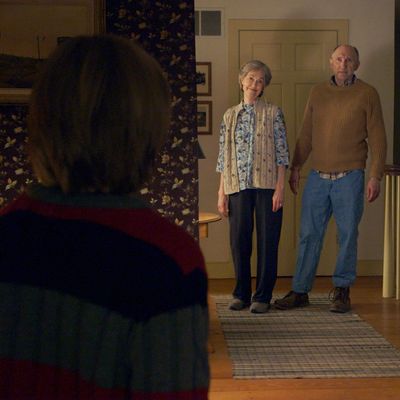
Somewhat slowing his slide into irrelevance, “the next Spielberg” (loco citato, Newsweek — emphasis on loco) M. Night Shyamalan has come up with an unoriginal faux-doc horror picture that actually works like a demonic charm.
The Visit centers on two kids — 15-year-old Becca (Olivia DeJonge), a fledgling filmmaker, and 8-year-old Tyler (Ed Oxenbould), a fledgling rapper and full-fledged smartass — who travel to their grandparents’ rural Pennsylvania farm.
From the outset, the Shyamster’s themes make your nostrils twitch with the scent of significance. The kids’ single mom (Kathryn Hahn) left home as a teenager under murky circumstances and hasn’t communicated with her parents for 15 years. So the grandparents don’t know the kids. The kids don’t know the grandparents. And the kids have only elected to make the eponymous visit (following an out-of-the-blue invitation from their “Nana” and “Pop Pop”) because they want their mother to have a week to bond with the latest in a line of Mr. Rights since their despised father decamped. “We’re doing this so mom can have a life,” Becca reminds her brother.
You see the issue. The family has been fractured on every level, and in a genre as fundamentally conservative as horror, such fractures offer a place for demons to nest. Even stable families can come apart when the bodies and minds of the more aged members begin to fail.
Now, for a non-spoiler: If those grandparents — played by Deanna Dunagan and Peter McRobbie — were normal, then this wouldn’t be a horror movie. So they’re not, and this is. But what is the nature of their malady? Becca, who has chosen to make a documentary about the visit, attempts to interview her Nana on the subject of her mother’s estrangement. The question causes Nana’s head to gyrate madly. Other questions emerge: What’s in the shed? What’s in the cellar? Why is Nana staggering through the hall after dark night expelling vomit with her hair down? By way of explanation for the latter, Pop Pop invokes the mid-stage Alzheimer’s symptom called sundowning. But he and Nana are still plenty creepy when the sun is up.
The Shyamster couldn’t be more obvious in his method and intent. Beneath all his pretentions (in The Narf in the Bathtub — or whatever the hell that film was called — he suggested that he was literally God’s gift to humankind), he’s a B-movie gimmick-meister, a less fun William Castle. Most of us can see The Visit’s climactic plot twist staggering toward us from far off, trailing tatters of implausibility the way Kharis the Mummy trails moldy bandages. Along the way are Paranormal Activity–like hidden camera bits, false scares, sudden LOUD noises, and a bunch more obvious tricks to make the audience shriek on cue.
But the audience does. Dunagan is all in — whey-faced, blood-eyed, her white hair hanging like a shroud, parading her bare, aged ass in what reads as an act of cinematic blasphemy. She has a great unnatural laugh. McRobbie is a bit more stilted, but his hammy intonations somehow add to the eerie vibes. The kids are impossible to dislike. The running joke is that DeJonge’s ultraserious Becca holds forth on her cinematic ambitions — in a clever Shyamster meta-touch, she speaks of creating visual tension by hinting at things outside the frame — while Oxenbould’s Tyler impishly deflates her. His lisp is adorable. We don’t want anything to happen to either one.
Give Shyamalan this: He’s not a cynic, a nihilist, or a cynical nihilist — i.e., a filmmaker who leaves his monsters alive for no reason other than the hope of sequel money. The Visit has a rounded structure and a moral befitting a fairy tale. It’s an obvious movie, but a very decent one.


